The Royal School of Needlework has added to their collection of Essential Stitch Guides lately. The new title is Whitework, by Lizzy Lansberry. As soon as I heard the book was out, I ordered a copy right away – not only to review it for you, but also (and especially) because I love whitework. I figured if this book measures up to the other Stitch Guides produced by the RSN, then it’s bound to be a keeper!
And it does. And it is!
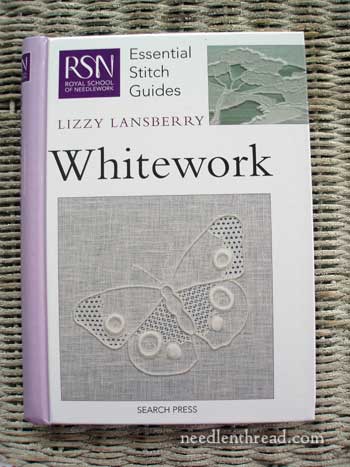
Like the other books in the Essential Stitch Guide series, Whitework is a small book with hard board covers and a spiral binding. I admit, I love the size and binding of these books! The books are about 9″ tall and 6″ wide, and the binding is that “full Canadian” spiral binding – they’re bound with wire rings, but the outside cover covers up the spiral, so you really only see it when you open the book. I know book aesthetics aren’t everything, but I appreciate this detail. Instructional books are meant to be used during work, and being able to easily lay the book open on the table is a nice, thoughtful detail.
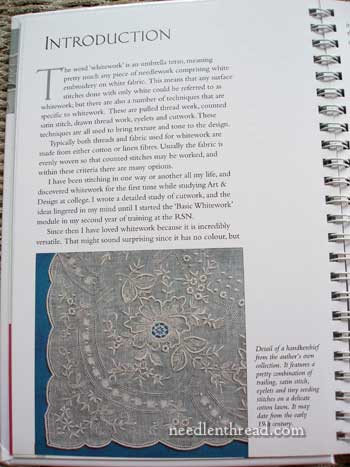
But let’s move inside the book, where the meat of the matter is. The book begins with an introduction, followed by a short history of whitework. Throughout the book, gorgeous examples of whitework serve as inspiration. In the introduction, the author clarifies that “whitework is an umbrella term” for white-on-white embroidery. And the book addresses whitework in this way – general whitework techniques.
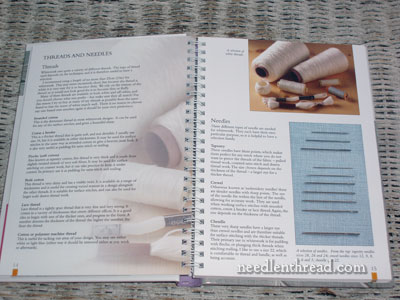
There’s the essential section on materials, which covers equipment, fabric, threads, needles – all that needful information! The author itemizes different types of threads that are used in whitework, which is nice information to have written down in one place, especially if you are just starting to explore this type of embroidery.
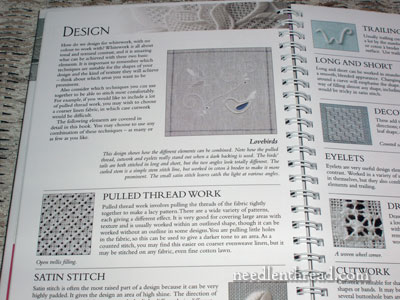
Next up is a section on design, followed by a section on designing your own piece. This section on design is important. As the Lizzy points out, in whitework, you’re not working with color, which is often a key approach to designing other types of embroidery pieces. With whitework, texture and tonal contrast are the key, and in fact, this whole book is logically arranged around this point.
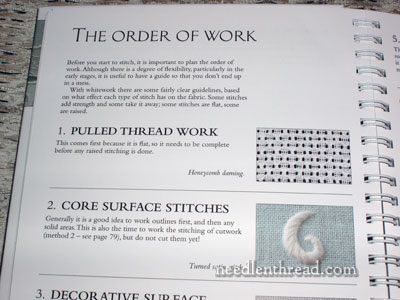
How does one achieve textural and tonal contrast in whitework? It is all about what you do with the ground fabric and what you do with the stuff you put on top of the ground fabric. So the book is arranged according to the order of work in whitework. The main instructional sections in the book, in order, are: pulled thread techniques on the ground fabric, core surface stitches, decorative surface stitches, eyelets, drawn thread work, and cutwork.
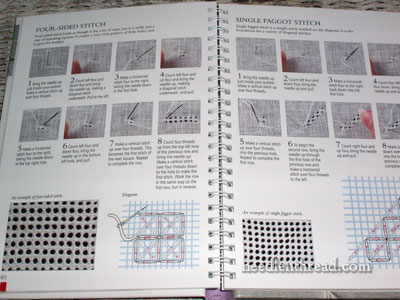
In each of these instructional sections, you will find thorough step-by-step photos illustrating the techniques, as well as diagrams and photos to illustrate the completed technique.
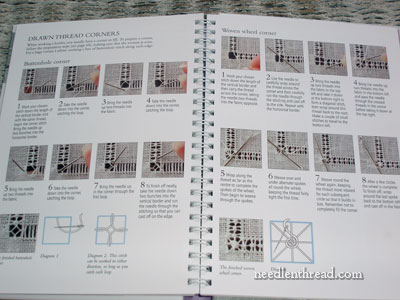
This instructional content is where the book really shines. It is logically arranged and thorough in its explanations. And, as is often the case with many instructional needlework books, the techniques taught herein can extend beyond whitework.
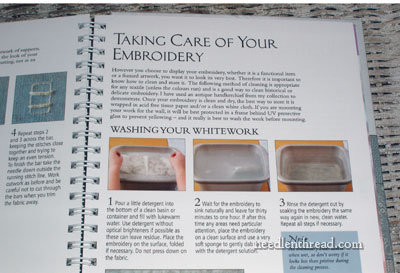
Then there are the “extras” in the back of the book – there’s a useful section on taking care of whitework.
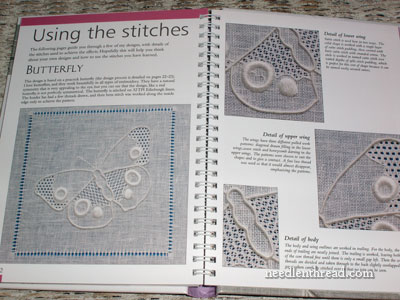
There’s a section on using the stitches – putting into practice the techniques learned in the book. Keep in mind, this is not a project book, so this section does not lay out projects for you to work. Instead, it demonstrates, up close, how the techniques taught in the book were put into practice in various whitework projects.
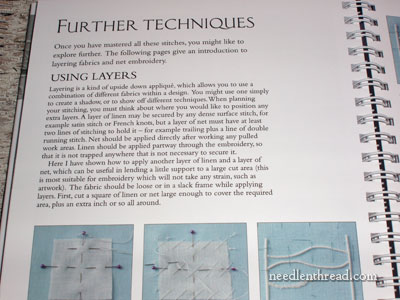
Finally, there’s a section on additional techniques that are often used in whitework, such as layering fabrics and working on net.
There isn’t too much about this book that isn’t likable, especially if you have even a hint of interest in whitework. It is concise, clear, direct – and best of all, it is logically arranged. The book makes sense. It’s not just random information about whitework all compiled together. Rather, it uses the whole order of work in whitework embroidery to logically progress through the instruction in the book.
Where to Find It
Whitework by Lizzy Lansberry is an excellent little instructional book!
In the US, you can find the RSN Essential Stitch Guide for Whitework available here through Amazon.
The Book Depository also has Whitework in stock. It works out to about the same price right now, when you figure the currency conversion. But Book Depository ships free around the world, so you’ll save a little bit on shipping.
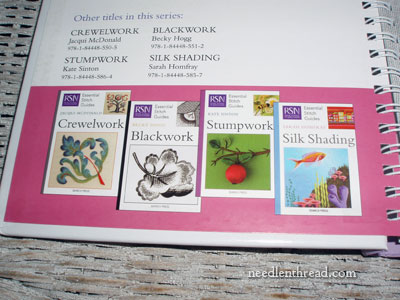
You can find all my reviews for the other RSN Stitch Guides in the Books section here on Needle ‘n Thread. Some of them are better than others – my favorites so far are Crewelwork and Whitework. The others are good, but I think the crewel and the whitework books are especially excellent. Can’t wait to see a goldwork book in the same series!
This article contains affiliate links to Amazon and to Book Depository, which means that Needle ‘n Thread receives a small commission for any purchase made through the link at no extra expense to you. Every little bit helps keep Needle ‘n Thread going! Thanks!







oh la la, the white embroidery, I rush to buy it, thank you for the information, even if I tempted so easily!
I preordered my copy months ago. Got it the other day and Wow I love it. It’s making me take a look at white work in a whole different light! Thanks again for doing this blog it’s the best!
Hey, Mary, sounds good. I’ve already ordered the book so was interested to see your review. Question: does it include wrapped bars? Not like hardanger, rather, single bars like you see sometimes in table cloths and other linens. Or, do you know how to do them? They are really stiff.
Thanks, Anne
…And Lizzy is a good instructor, too! I took her class at the RSN and did the butterfly pictured in your post.
Whitework, my favourite!!
Mary, thank you so much for your review..just ordered book, can’t wait to get it.
This book looks very good Mary, thanks for your review. You mentioned something about this book having a “full Canadian” spiral binding. I too appreciate it when a book has been designed to be used. I remember you mentioning awhile back that you were going to show us how you “deconstruct” some of your favorite needlework books. I was intrigued and wonder if I missed your post or if you are still planning to share with us in the future. Your idea sounded quite interesting to me, and I can think of many books that I would love to redesign so they are easier to use and work with. Is there any chance you might share your methods?
Hi, Pamela –
When I really need a book to be spiral bound, I cut the pages and take them to Kinko’s, Office Depot, or the like, and have them punch it and put a spiral binding in it. I’ve only done that with a few books – they were instructional books, but they were so tightly spined (if that’s a word), that they just wouldn’t stay open. If I book stays open with a little coaxing, I don’t do it, but for the ones that need it, definitely. Hope that helps! ~MC
Thanks Mary, yes, that does help and it makes perfect sense. I have several books at home and at school that I share with my students that seem to get alot of attention, and of course, pages fall out and get lost. Many are great older reference books and can’t be replaced, so your solution would be a good way to preserve them and still use them. I’ve thought of cutting pages out and putting them into three ring binders using slide in page protectors, but that makes them bulkier and some pages don’t fit well into the plastic sheets. Your solution sounds like something I could live with. Thanks again.
Hi Mary, I just saw on Amazon that RSN will be releasing a Goldwork book in Nov 2012. So I guess your dream is coming true and so it mine.
I just wanted to say that I’m thrilled to have found your site. I was a cross-stitch child of the ’80s, like your sisters. Recently, though, I’ve fallen in love with handkerchiefs and have been entertaining the idea of embroidering some plain ones. Today I found your site by doing a Google search and am so excited! I have a couple of books at home – one on white work and one that, if I recall correctly, is a rather large compendium of needlepoint information. I’m eager to get home, find out and let you know. I’m also eager to try out some of your tutorials. Enough rambling. Thanks again!
Hello Mary,
I just read your email, and your review on the book. Wow this is why I like embrodery so much.
Books are fantastic, you get pictures, explanations and models to make.
I love embroidery, I have tought Hardanger Embroidery wich is my all time favorite. It’s rewarding to create a piece on a blank fabric.
As I follow the pattern, I see the model come to life. And they become heirloms for my daugther and grand-daugthers. I give away almost every piece that I make. I keep nothing for myself. I prefer to give so others can enjoy this beautiful work.
I have tried many other types of embroidery. I love threads and fabric so much. Colors are
their for us to create incredable pieces.
Thank you for your great work and never stop.
Have a great day.
Louise
I love your review of the RSN’s Whitework Book. I had looked at it on RSN’s website a week ago. You really explained the layout and your opinion makes one want to purchase it.
Being an Artist, I love artwork! Embroidery is another way for me to express my art. I learned embroidery from my grandmother on pillowcases when I was seven or so years old. On my own I have learned some needlepoint and cross stitch. Now that I am retired and reaching seventy, I am getting back into the art of needlework. I think at this time, I am intrigued and excited with learning more with Helen Stevens. Her work is beautiful, as is Shay Pendray, and of coarse you, Mary.
Hello,
Whitework has become my favorite needlework and the RSN book is a must have! The instruction section is the feature I’m needing–the well-diagrammed step by step photos and clear explanations. Lizzy is a talented teacher who is able to “talk” to students on the pages! This book is a “must-have”! Thank you for reviewing it for us.
Hi Mary
I bought this book after reading your review! It is all what you said it is..
I just wish to know if this book and the A-Z of Whitework book by Country Bumpkin publications are similar? Do you think that buying the “A-Z of Whitework” would be of additional reference for whitework?
A-Z of Whitework gives more in-depth instruction on actual stitches used in whitework in general, along with all the step-by-step photos the books are known for. It’s very general – I like it, but I like the RSN book a bit better. There’s content in the A-Z book that you won’t find the RSN book, and visa-versa, so in a sense, they can compliment each other, but overall, the A-Z book is very general and it covers basic technique used across many whitework techniques. They were talking about a sequel to that book once upon a time, but I don’t think it ever got published.